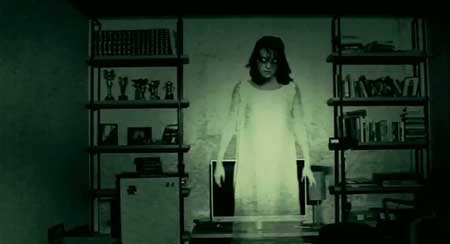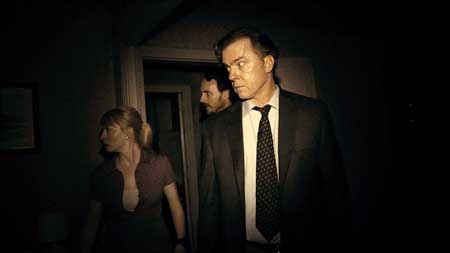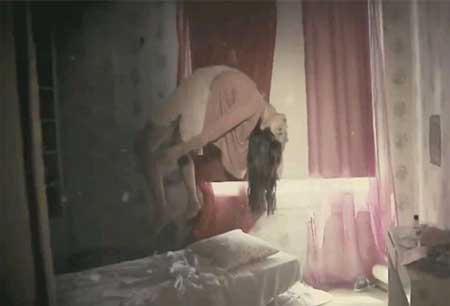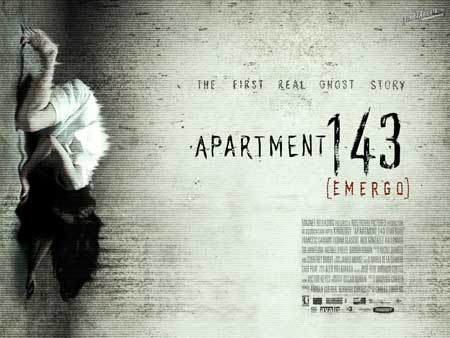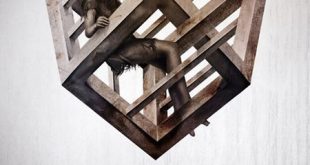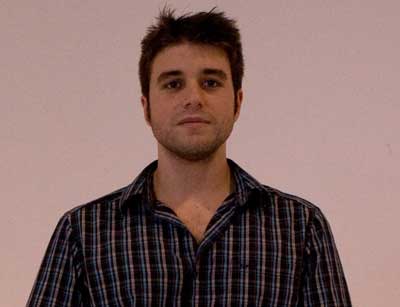 Director Carlos Torrens has just seen his first full length feature “Apartment 143 (Emergo)” released to both theaters & VOD. The latest addition to the “Found Footage” canon, It tells the story of a team of parapsychologists who set out to investigate a series of anomalous phenomena taking place in a newly occupied apartment. Telephone calls with no caller, mysterious shadows, extraordinary light emissions, flying objects, and exploding light bulbs, are some of the events they face while recording their every step with state-of-the-art technology. Using infra-red filming, digital photography, psychophonic recordings, movement detectors, and magnetic field alteration meters, the group’s attempts to contact the “other side” will grow increasingly dangerous as they near a point of no return… Mr. Torrens was gracious enough to speak with Horrornews about making his first film.
Director Carlos Torrens has just seen his first full length feature “Apartment 143 (Emergo)” released to both theaters & VOD. The latest addition to the “Found Footage” canon, It tells the story of a team of parapsychologists who set out to investigate a series of anomalous phenomena taking place in a newly occupied apartment. Telephone calls with no caller, mysterious shadows, extraordinary light emissions, flying objects, and exploding light bulbs, are some of the events they face while recording their every step with state-of-the-art technology. Using infra-red filming, digital photography, psychophonic recordings, movement detectors, and magnetic field alteration meters, the group’s attempts to contact the “other side” will grow increasingly dangerous as they near a point of no return… Mr. Torrens was gracious enough to speak with Horrornews about making his first film.
HN: This being your first full length theatrical feature, why did you choose to make a ghost story?
CT: Well you know it was more of a chain of events that lead me to make this my first film. I’m a big fan of Rodrigo Cortes who wrote & directed a wonderful film called “Buried” a while back. He’s also a friend of mine as well and basically he had this script that he was planning to direct at some point in the future. But after making “Buried” he went on to bigger & better things and this created something of a window for me. to be considered to be one of the candidates to direct this film. I hadn’t planned to making a ghost story but it was an great way to work closely with Rodrigo & I just loved the story and I loved the inherent challenge it presented to me as a filmmaker so I very gracefully accepted their offer to direct it.
HN: Are you a fan of the “Found Footage” genre?
CT: I don’t really like “Found Footage” films that much and I’ll tell you why. When this project was concocted “Paranormal Activity” had JUST come out. “PA2” hadn’t even begun production at the time. So we approached it very differently, if you consider a film like “REC” or “Cloverfield” a found footage film then those are films that I like. Because those films are basically tricks, nothing is improvised and everything is well calibrated. Every little camera move is there for a reason so they’re just regular films which can be filmed normally if you have a good narrative way to tell the story and those films I do like. The more traditional “Found Footage” films in which basically there is a bare boned script & everything is improvised those films I don’t like because I feel that there is no tension, I don’t feel like they’re tight. So the way I approached “Apartment 142” was different from your typical “Found Footage” film because it was a screenplay that was completely locked that you could have shot normally. Robert Zemeckis could’ve shot it with your garden variety dolly, crane & steadicam shots and it would’ve worked just fine. What I liked was the challenge of telling that same story, hitting those same beats, achieving the same level of suspense but with a film language which was at that point, rather ground breaking & experimental. That’s basically how I approached it so I never really considered it a “Found Footage” film. In addition, no one finds the footage in the woods, we never really say that. It’s an experiment that’s being filmed by the parapsychologists in charge and what you are seeing is the footage that they got in the course of their experimentation.
HN: The way you used the combined footage from all of the cameras, both fixed & handheld, was really unique. Was that built into the script or was that something you worked out as production began?
CT: That’s one of the reasons that I agreed to direct the film, so that I could play in their sandbox! That was my challenge as a director…to come up with a way to work with all of those cameras. Thanks by the way, I really appreciate you appreciating the style because at that point I think “Paranormal Activity 2” was the first mainstream film that I had seen with all of the security cameras. A lot of those ideas that had come up since I had in my mind without any visual reference so that was in the script. And it was a lot of fun because obviously the script was meant to be shot like this and up until the various camera shots start kicking in you are told in the script that the cameras are being set up by the scientists and that a lot of them are hand held but it’s not specific. So for example, the script told me what’s happening but it didn’t tell me how to shoot it so I had to come up with camera positions just like in a normal movie but they all had to be justified. I decided to tell the story through different cameras, camera positions, camera moves & camera textures. Those were my narrative tools, my notes if you will. Every little camera placement & texture serves a narrative purpose, they’re there for a reason. There’s nothing really arbitrary even though it’s supposed to look like you’re watching an episode of “Big Brother” where you’re just hoping to see every moment from every camera that’s filming everything you see, in my film it’s very much a narrative decision so to speak.
HN: I noticed a few familiar faces in the cast, Michael O’Keefe & Rick Gonzalez being chief among them. The rest of the cast were (Although wonderful) unknown to me. Were screen tests mandatory to fill the various roles in the script?
CT: We went through a very extensive audition process actually. I wanted the best actors possible but I also wanted unknowns which is clearly a paradox because if they’re so good why are they unknowns, right? Michael O’Keefe is a very good actor but he’s also shown a lot of different looks in his career so maybe you might recognize him from “Caddyshack” or “The Great Santini”. Rick Gonzalez was just so good, at the end of the day acting & performance were my priority so in the case of Gonzalez if I had found an actor just as good as he was but not as well known I would’ve went with him but Rick was just too good and I had to have him! Everyone came in & auditioned in the end. We did have some “Show Biz” kids come in to audition and by that I mean kids who have been in the industry for awhile but I decided to go with an unknown who had never been in a movie before, Damian Roman who played Benny White had never acted in a film before this one but he did come in and audition like everyone else did.
HN: The film has a very “Real” feel to it. It didn’t feel like I was watching the movie, I felt like I was watching a documentary and I think a lot of this feel came from the script and way the character development progressed. especially the dad (Kai Lennox). I was wondering if there was a lot of ad libbing that took place during production or was all of this already in the script?
CT: Everything came straight from the script. The whole point of this film is that you see a series of events unfold in front of you from a very cold, detached, distant look. Although you do see the supernatural stuff from all of the cameras that are set up all over the house inevitably they start recording the relationships between the living components of the family. So suddenly it acquires a voyeuristic feel and family secrets will inevitably be exposed and brought to the surface whether that was intended or not. That’s why characterization is so important, the characters had to feel like real people. The characterization was very well mapped out in the script and we had to work very hard with the actors. We did extensive character breakdowns, extensive rehearsals & we even had the actors keep journals about their experience making the film as production continued. My main priority was to make sure the characters felt real. Especially the character of Alan White played by Kai Lennox, his character arc is the backbone of the film. His character and what he goes through and the way that he meets his catharsis is what makes the film so everything had to be built around his character. For that to work, nothing could be left to random. Everything was very well rehearsed and purposely put together and studied.
HN: Well it was all very well done!
CT: Thank you!
HN: There were a few scenes where a device was being used by the parapsychologists in their investigation and it was pixelized on screen. I was wondering why?
CT: Well there’s no secret to what the device is and what it’s being used for. I’m playing a game with the audience that the film is an experiment being conducted by the parapsychologists. They are running tests and just in case that the footage was going to be seized by the authorities in conjunction with a case that might stem from what they were doing they decided that some of their instruments really weren’t meant for the general public to see. So these instruments were pixilated out. There has been some real government tapes that have been around for decades that still haven’t been shown to the general populace after all of this time and that’s where we were trying to go with this conceit. It lends an air of mystery to all of the goings on.
HN: The word “Emergo” is part of the title of your film. Why was that added to the title? Why isn’t the title just “Apartment 143”?
CT: “Emergo” is a Latin word. The film was originally titled “Emergo”, it was changed for the American release. And we thought it would be a pity to lose that word because the word “Emergo” means “To Emerge” and it’s very relevant to this film because we have several things emerging. They might be of supernatural or paranormal but that’s for the audience to decide. origin and we also have family secrets emerging as well. You have something emerging out of the character Alan White which is the key to the whole film. So that’s why we picked that title.
HN: Is there a sequel planned?
CT: I have a couple of projects in the simmering in the oven but you know this is my first film & I just signed with an agency. I’m learning that until you sign a contract & you’re in pre-production a project can fall apart very easily & new ones can pop up at any minute so I’d rather not talk about them until I know that they’re on track. But I do have a couple of things in the oven…
HN: One last question regarding the ending of the film. As the last characters left the apartment the camera was set on a picture hanging on a wall. The camera stays on the picture for the longest time, so long it almost felt funny but it was more a case of laughing to soothe my nerves because I knew something was coming. But for the longest time nothing happened when suddenly…well I won’t say what happened but I was wondering if the amount of time that you spent on the picture hanging was in the script as well or was it a choice you decided to make because quite honestly it felt like the shot went on for five minutes before something happened!
CT: It’s not all about showing the audience a monster. It’s all about f*cking with the audience as long as you can! It’s suspense 101 basically, yes it was in the script. It was expected of me to do it like that but there was no notation describing the length of time that the shot required so it was up to me to decide how long I wanted to stretch it out. I find that anticipation is the key when you’re making a film like this and that’s what the producers expected of me. To play with the audiences expectations and make the moment last as long as I could possibly could.
“Apartment 143: Emergo” is available now on VOD and in limited release as of June 1st.
Interview: Director Carles Torrens (Apartment 143: Emergo)
 Horror News | HNN Official Site | Horror Movies,Trailers, Reviews
Horror News | HNN Official Site | Horror Movies,Trailers, Reviews
